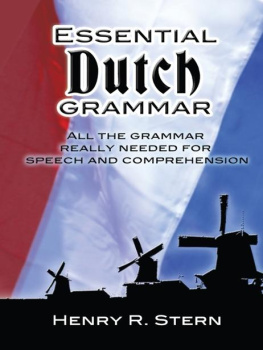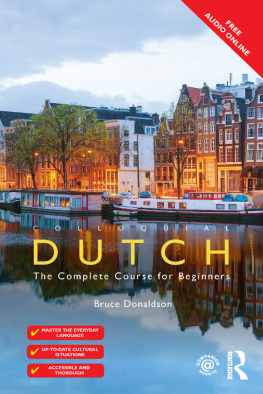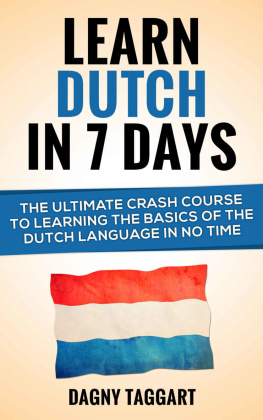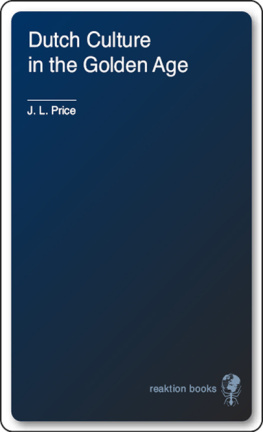Koen Noltus - Dutch: The Dutch Language Learning Guide for Beginners
Here you can read online Koen Noltus - Dutch: The Dutch Language Learning Guide for Beginners full text of the book (entire story) in english for free. Download pdf and epub, get meaning, cover and reviews about this ebook. year: 2020, genre: Detective and thriller. Description of the work, (preface) as well as reviews are available. Best literature library LitArk.com created for fans of good reading and offers a wide selection of genres:
Romance novel
Science fiction
Adventure
Detective
Science
History
Home and family
Prose
Art
Politics
Computer
Non-fiction
Religion
Business
Children
Humor
Choose a favorite category and find really read worthwhile books. Enjoy immersion in the world of imagination, feel the emotions of the characters or learn something new for yourself, make an fascinating discovery.

- Book:Dutch: The Dutch Language Learning Guide for Beginners
- Author:
- Genre:
- Year:2020
- Rating:3 / 5
- Favourites:Add to favourites
- Your mark:
- 60
- 1
- 2
- 3
- 4
- 5
Dutch: The Dutch Language Learning Guide for Beginners: summary, description and annotation
We offer to read an annotation, description, summary or preface (depends on what the author of the book "Dutch: The Dutch Language Learning Guide for Beginners" wrote himself). If you haven't found the necessary information about the book — write in the comments, we will try to find it.
Koen Noltus: author's other books
Who wrote Dutch: The Dutch Language Learning Guide for Beginners? Find out the surname, the name of the author of the book and a list of all author's works by series.
Dutch: The Dutch Language Learning Guide for Beginners — read online for free the complete book (whole text) full work
Below is the text of the book, divided by pages. System saving the place of the last page read, allows you to conveniently read the book "Dutch: The Dutch Language Learning Guide for Beginners" online for free, without having to search again every time where you left off. Put a bookmark, and you can go to the page where you finished reading at any time.
Font size:
Interval:
Bookmark:
Copyright 2020
The views expressed are those of the author alone, and should not be taken as expert instruction or commands. The reader is responsible for his or her own actions. Adherence to all applicable laws and regulations, including international, federal, state and local laws governing professional licensing, business practices, advertising and all other aspects of doing business in the US, Canada, UK or any other jurisdiction is the sole responsibility of the purchaser or reader. Neither the author nor the publisher assumes any responsibility or liability whatsoever on the behalf of the purchaser or reader of these materials. Any perceived slight of any individual or organization is purely unintentional.
Table of Contents
Part 1: Dutch for Beginners

NOTE : The vocabularies of this book are spread over the content.
Each vocabulary is with the conversation or topic it belongs to. This prevents having a long list at the end of the book. Moreover, the learning of new words will be more gradual, and therefore, more pleasant. You might find some overlap, but that is just part of the learning process.
Introduction
They pride themselves on speaking several languages, which is a necessity since relatively few people speak Dutch. Straightforwardness is also part of their culture, so be sure to take the lead in a conversation. Be bold, but in a pleasant way! In this book, you will not only discover the basics of the Dutch language but also learn more about the Dutch people, such as their habits and behaviors. Make sure to be open-minded with the correction of your pronunciation, words, and conjugations. Ask your family, friends, or fellow students to test you as you go. Before long, you will have mastered Dutch for Beginners !
Part 1 The Very Basics
They should not be twisting your tongueyetso you can grow accustomed to them pretty fast.
- een eyn
- twee twey
- drie drea
- vier vear
- vijf - veif
- zes cs
- zeven zayven
- acht agggt
- negen naygggen
- tien tean
- elf elv
- twaalf twaalf
- dertien dairteen
- veertien veerteen
- vijftien veifteen
- zestien csteen
- zeventien zayventeen
- achttien agggteen
- negentien naygggenteen
- twintig twintigggg
So, 23 is like 3 and 20 = 3 en 20; 26 is 6 and 20 = 6 en 20. It goes on like that up to 100. The tens: 10 teen 20 twintiggg 30 drtiggg 40 faertigggg 50 veiftiggg 60 cstiggg 70 zayventiggg 80 taggtig (mind the t!) 90 naygggentigg 100 honderd = hondurt 101 honderdeen 102 honderdtwee 130 honderddertig 165 honderdvijfenzestig 200 tweehonderd 300 driehonderd 1000 duycent Of course, once you see the logic of it, you can learn this by heart. Test yourself to see if you really know how to count: Tiny task #1: 13 = 8 = ; 27 = ; 63 = ; 78 = ; 104 = ; 12 = ; 140 = ; 549 = ; 636 = ; 244 = ; 82 = . How to say it in Dutch? Check the answers at the end of the book!
Morning ochtend or morgen morgggen Afternoon middag middaggg Evening avond afont Night nacht nagggtt Dutch glues the two words together when they want to indicate a specific part of the day: Monday evening maandagavond; Saturday afternoon zaterdagmiddag.
Font size:
Interval:
Bookmark:
Similar books «Dutch: The Dutch Language Learning Guide for Beginners»
Look at similar books to Dutch: The Dutch Language Learning Guide for Beginners. We have selected literature similar in name and meaning in the hope of providing readers with more options to find new, interesting, not yet read works.
Discussion, reviews of the book Dutch: The Dutch Language Learning Guide for Beginners and just readers' own opinions. Leave your comments, write what you think about the work, its meaning or the main characters. Specify what exactly you liked and what you didn't like, and why you think so.









